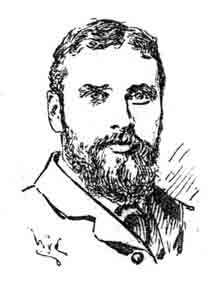Peter Dawson.
Distiller and Whisky Merchant, 99 Maxwell Street, Glasgow.Mr Peter Dawson. 1891.
Mr Peter Dawson, Distiller and Whisky Merchant, 99 Maxwell Street, Glasgow. In 1891 Mr Dawson had already made a name for himself in the United Kingdom as a blender of whisky and practical distiller. He was born in one of the great distilling districts in Scotland, Glenlivet, a wild upland village far removed from the mad hurly burly of the cities, and hemmed in by heather-clad hills and precipitous crags, where the dun-plumed eagle builds her eyrie and the fierce mountain hawk rears its young. It is a peculiarly remote glen and the pedestrian traverses miles of moorland before coming across the abode of men. The solitude is broken only by the bur-beck of the moorcock, the wail of the plover, and the whirr of the strong-winged ptarmigan. It is here that the world famous Glenlivet whisky is distilled, and it was here that Mr Dawson acquired that thorough knowledge of distillation and blending which he earned for him a reputation and a fame which no other Scotsman can claim.
Mr Dawson comes from a long line of distillers whose fame yet rings in rich remembrance through Dufftown and its environs. In 1802 Mr P. Dawson's grandfather laid the foundations of a business which has, in later years, moulded the quality of Scotch whisky throughout the empire. The founder of the concern, ever anxious to maintain a reputation for the purity of his distillations, seems to have handed down his share of solicitude to his son, whose mantle in due course has fallen upon the not-unworthy shoulders of the grandson, Mr P. Dawson.
The colossal nature of Mr Dawson's transactions as a whisky blender must seem to many readers at least a work of subrogation, for who in Scotland can have forgotten the excitement caused throughout the city of Glasgow in November 1890, when it was announced that he had blended at one great inpouring no fewer than twenty thousand three hundred and seventy gallons of whisky, the component parts of which represented the matured products of twenty-five first class stills, and the total weight of which realised rather more than sixty tons. The diameter of the vat was eighteen and a half feet, and the depth of eight feet. It was surrounded with eight iron hoops weighing 1 cwt each. This mammoth admixture transactions, and we may confidently infer that his trading connection, extending as it does over a cosmopolitan area, is of the most titanic proportions.
No fewer than six travellers are employed, not so much in the laudation of Mr Dawson's whisky blends for these best recommend themselves but rather in watching the interests of the numerous and influential clientele, who are distinctly concerned in keeping up an increased supply of these deftly-amalgamated potations. Few men are engaged in the busy round of Glasgow's commercial activity are either consciously or unconsciously doing more to further the most substantial reforms in the more pernicious of Scotch customs than Mr Dawson, and herin lies the true answer to the advocates who worship at the shrine of Sir Wilfrid Lawson, and enlist, themselves under the argumentative threadbare banners of the United Kingdom Alliance.
Medical science has, during the last quarter of a century, done much towards the extirpation of disease and the prolongation of life, but it has signally failed to grapple with one of the greatest problems of the age, drunkenness. It stands helpless in the face of this evil and admits its inability to cure the dipsomaniac. Mr Dawson has realised the important fact that there is no use in trying to cure the drunkard from the purely religious and moral sides. His emotional powers are impaired, and his will-power has lost its strength. He must be dealt with from the physical side. Let temperance reformers turn their attention from vapid outbursts of intolerant bigotry and un charitableness to a reforming zeal in the matter of minimising the evil. Villainous decoctions which, sold under the honorable designation of Scotch whisky, constitute what Carlyle has designated the "insidious brain stealer and soul paralyser." The influence of purely-blended and well-matured Scotch whisky, such as MR Dawson stands sponsor for, at once supplied a valuable adjunct to the best resources of human society, and vindicates the wisdom and moderation of the ancients, who regarded Bacchus as the preserver of good fellowship and the divine worker of human reconciliation. Mr Dawson is working as earnestly in the temperance cause as the most rabid lecturer of the Temperance League. These men have failed with religious appeals, moral suasion, and pledges to reduce drunkenness. The latest returns show that the evil is on the increase. Mr Dawson says, "I believe that public taste is tending towards blends rather than to single whiskies, and that skilfully-blended liquor of ascertained and undoubted maturity would speedily displace those immature inferior, and un-wholesome spirits which are frequently put on the market. I am working in the cause of temperance, because if men and women must have whisky, then, I say, let them have it pure and the best that can be manufactured. It is the immature and drugged whiskies that do the harm, steal away men's brains, and create appetites and quenchless cravings."
Before coming to Glasgow Mr Dawson owned the well known distillery of Auchnagie, Ballinluig, near Pitlochry, where there was an annual output of between 50,000 and 60,000 gallons. Here is how a writer describes the scenic splendours surrounding the distillery, " The whole of this beautiful Strath Tay is one continued scene of the beauty of nature in its simplest, widest, and most imposing richness and stillmess of the whole; the fragrant birches, graceful hazels, rolling hills of the greenest verdure, and background of mountains all form some of the richest pictures on which the eye could wish to gaze. At the time of our visit to Auchnagie Distillery the works had ceased operation, as the weather was to hot for malting. The distillery consists of a barley loft, malting still, and mash house, and a few other buildings, including spirit stores and warehouse accommodation for 40,000 gallons. The water used comes from the Auchnagie hills, and the make is Highland malt. Only peats brought from Loch Broom are used in drying the malt. One exciseman is employed at the distillery who informed us that he leads quite a pastoral life here, and spends his summer days in his garden and little farmyard."
Besides a distiller and blender Mr Dawson, jointly with Mr Dowell, is the inventor of what is known as the Dawson-Dowell Patent Lorry Drag, which has completely superseded the old-fashioned chain and shoe drag for lorries. Although of the simplest construction, the drag is likely to prove to carting contractors and others a great boon, particularly in a city like Glasgow where there is so much vehicular traffic. In applying the drag the driver does not require to leave his customary place in front of the lorry; all that he has to do is to unhook the ring attached to the wire cord, when the drag immediately comes into action, wheather the lorry is on a hill or level or should the horse run away. The driver has no difficulty in releasing the drag. He pulls the ring on to the hook without having to leave the front of the lorry, and always maintaining control of the horse. The shoe when worn can be renewed and easily and quickly attached without any further expense for the other parts, which are practically indestructible. The drag has been fully tested, and its utility demonstrated beyond question. One of the best known carting contractors in the city wrote, "I have much pleasure in testifying to the efficiency of the Dawson-Dowell Patent Lorry Drag, having had the first two which were made fitted on my lorries for the past three months in constant use. It does its work admirably, saving man and horse, and is an immense saving of time, as no stoppage is necessary at top of hill, the drag taking effect without fail at once. The man has always control of his horse, being constantly at front of lorry. It is the best and safest drag I have yet seen in all my experience."
All the daily and evening and weekly papers in the city have pronounced in favour of the drag, and within the next couple of years, we may safely predict, it will be in universal use throughout Scotland.
End.

